How to play Betrayal at House on the Hill: board game's rules, setup and haunts explained
Don't fear the rulebook.
Betrayal at House on the Hill is one of the best horror board games of all time. It's the perfect scary story collection, offering a box packed with 50 different spooky haunts for players to try and solve - and survive - together. But not everyone will be on the same side - one of your group may be a traitor, trying to work against everyone else to achieve their own aims and win alone.
The sheer variety of Betrayal's haunts is a big part of why it's remained so popular since it first emerged from the crypt in 2004. Each haunt has a unique story and setup, from players finding themselves shrunk to miniscule size and trying to escape a now giant cat in a toy plane to twists on classic horror monsters such as ghosts, ghouls and mummies.
The board game's variety can lead to a number of questions about rules, with each of the 50 haunts having potentially different gameplay changes. No need to shiver with terror, though - once you know the basics of how to play Betrayal at House on the Hill, you'll find it easy to jump into any of the haunts and focus on the fun of playing, rather than the rules.
How to play Betrayal at House on the Hill
- Player count, game length and overview: Find out how many people can play Betrayal and what you'll be doing.
- Setup: Take your first steps into the haunted house as we pick characters and lay down room tiles.
- Gameplay rules: We break down the rules for the board game's exploration and haunt phases.
- End of the game and how to win: Whether you're one of ths survivors or the traitor, learn how you can emerge victorious - or just make it out alive.
There are multiple fairly chunky rulebooks included in the game, which can be intimidating at first for new players. You can leave the Traitor's Time and Secrets of Survival to the side for the time being - you don't need to open them until the game tells you to. You can even skip the core rulebook for now, as we're here to run you through what you need to know about how to play - if you need to double-check any rules or just get a gist of what you'll be doing on your turn, this is the place to start.
So turn down the lights, cast a suspicious eye at your friends and prepare to get spooky, as we teach you how to play Betrayal at House on the Hill.
Player count, game length and overview
Betrayal at House on the Hill is a co-operative board game in which players explore a haunted mansion and attempt to survive the horrors within.
The game plays with three to six people, has a recommended age rating of 12+ and usually takes around an hour to 90 minutes to play. This can vary significantly depending on the haunt.
Setup
First, separate the Traitor’s Tome and the Secrets of Survival books from the rest of the game’s components - you’ll be needing those later on.
Players choose which character they want to play as. Character cards in Betrayal are double-sided, with a different version of each person provided on each side.
Besides their general personalities, characters are important because of their unique traits - some characters are better at certain types of traits than others. Forming a balanced team can help with the co-op elements of Betrayal, but players are welcome to pick based on personal preference as well.
Attach the little plastic arrows to each of the four trait tracks on your character card, moving them so they match the green coloured numbers - your starting traits.
You can also download unofficial Betrayal at House on the Hill apps on Android and iOS that can hold all your character information for you.
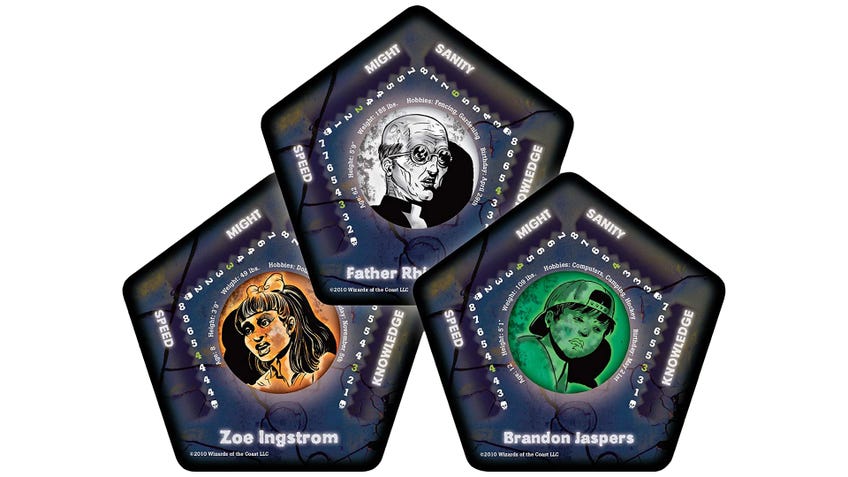
Take the omen cards, shuffle them into a deck and place them face down somewhere where all players can reach them. Do the same for both the item cards and the event cards.
Find the basement landing tile, upper landing tile and the longer entrance hall/foyer/grand staircase tile and place them to the side.
Find all the rest of the room tiles, shuffle them and place them facedown in a single stack. Place this stack within reaching distance of all players.
All players then find their matching character miniatures and place them on the entrance hall space. Character miniatures can be easily identified by checking the colour in the background of the character’s portrait on their character card. For example, Flash has a red background and a red top.
Take all of the game’s dice and place them within easy reach of the players.
Now to decide who goes first. Check to see which of the player’s characters has a birthday that’s closest to the current date - you can find character birthdays on their character card. The turn order starts from that character and moves clockwise.
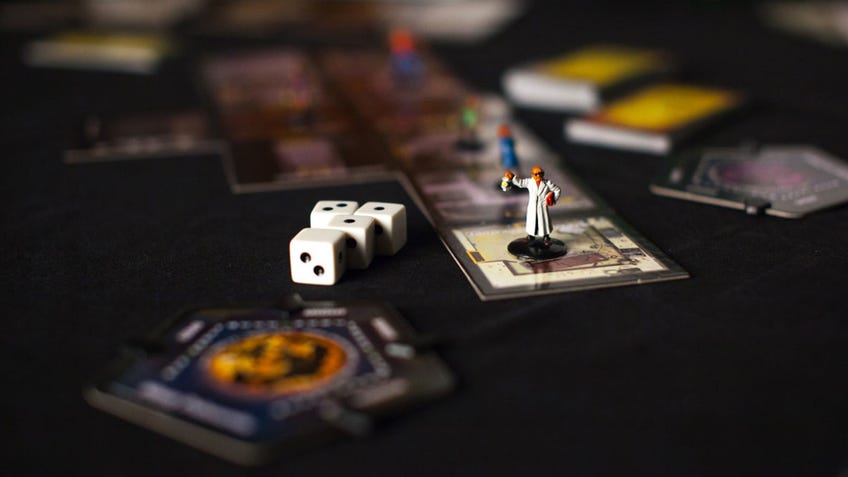
Gameplay rules
Betrayal at House on the Hill is split into two separate stages: the exploration phase, where all players are on the same team, and the haunt phase, where players are sometimes split into different teams depending on the haunt.
A set of various requirements decides which of the numbered haunt scenarios you’ll experience during a playthrough. However, until the haunt happens, you’ll all be walking around the mansion experiencing various spooky goings-on and gathering - sometimes - useful items.
Moving
Turns in the exploration phase usually involve players moving through the mansion’s rooms until they experience an event or an omen, or until they run out of movement. The number of rooms a player can move into and through is determined by their character’s speed trait. For example, if a character has a speed of three they can move through three adjacent rooms.
Whenever you move to exit a room, there must be a tile to move onto. If there isn’t a tile, you must find a tile matching the level of the house they are currently on. For instance, if a player’s miniature is on the ground floor, they need to find a ground floor tile from the room tile stack. Players draw room tiles from the stack until they find a matching tile before flipping it face-up and placing it adjacent to the tile they’re currently on.
Room tiles need to be connected via doorways. This means that a doorway shown on a room tile needs to be placed next to the doorway of another tile. Not all doorways will be able to be connected - that’s okay, as long as there is at least one way in and out of a room.
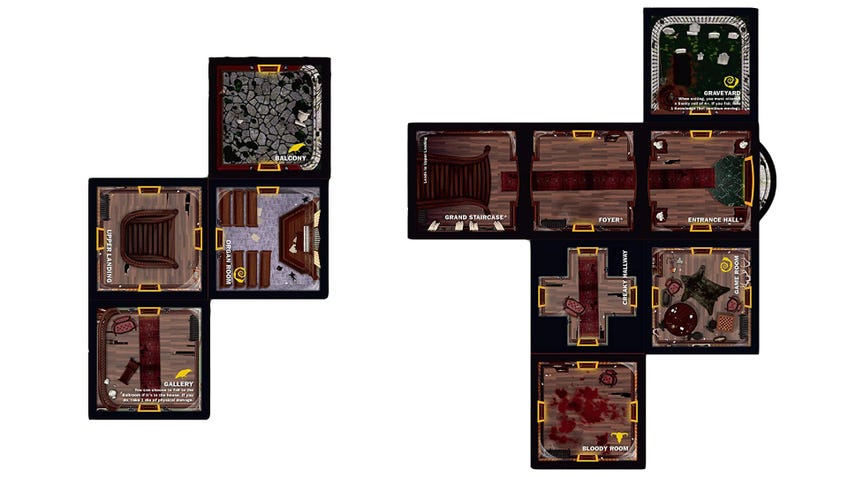
Some room tiles in Betrayal are special and must be placed in a very particular way. For example, the Mystic Elevator room only has a single doorway and actually teleports around the mansion whenever a player enters and rolls a particular number.
Other rooms force players to roll trait rolls in order to cross through to another room, whilst others offer players the chance to gain rewards if they pass a trait roll - we’ll get onto the specifics of trait rolls in just a bit.
If a newly-drawn room tile has the item, event or omen symbol on it, it means that the player must draw an item, event or omen card, immediately resolve it and end their movement. Item cards gift the player an item, which is placed face-up in front of them - it can be used that turn.
Event cards can lead to positive or negative consequences, with some requiring the player to pass a trait roll.
Omen cards usually grant the player a unique ability that may or may not be connected to the game’s haunt scenario. Regardless of whether the omen card is an obvious item or not, the player must place it on the table in front of them.
Trait rolls
Some rooms and event cards will require the player to perform a trait roll. Trait rolls involve one of your character’s four traits: might, speed, sanity or knowledge.
An event might refer to a specific trait or refer to either “physical” or “mental” traits. Might and speed are physical traits, while sanity and knowledge are mental traits.
If a reference is simply made about a physical trait, for example, you are able to choose which physical trait you might want to use for the applicable trait roll and divide any damage received across both traits, too. So you might use your speed trait to try and pass a physical trait roll but suffer damage in both speed and might, or just one of them.
To perform a trait roll, the player needs to take the number of dice equal to their current trait number and roll them. For example, if a player character has a four in knowledge, then they take four dice and roll them. Depending on the dice result, that player character will either pass or fail the trait roll. Whilst passes can result in positive effects - such as improvements to a character’s traits - a failure almost always results in a negative outcome.
The Haunt
Whenever a player draws a room tile with an omen shown on it, they must take an omen card and make a haunt roll at the end of their turn, meaning they must roll six dice.
If the resulting total is less than the current number of omen cards held by all players, a haunt occurs.
Whichever player causes the haunt to occur becomes the haunt revealer. (This is important for working out who is the traitor and which scenario is being played this game.)
When a haunt occurs, the haunt revealer opens the traitor’s tome to the first two pages - and ONLY the first two pages - and has a look at the chart inside. This chart will tell you which numbered scenario you are playing this game.
The haunt revealer checks the omen card they just drew and the room they were in, and finds the matching entry on the chart. The number of the scenario you are going to be playing is shown in the space where the omen card and the room meet.
Check the chart underneath the table to see which player will be the traitor for this scenario. (If there is a traitor.) This is often decided by whoever is holding a certain item or if the person was the haunt revealer.
If one or more players could be the traitor, it’s decided in one of two ways. If one of the possible traitors is the haunt revealer, then they are the traitor. If not, it’s the player closest to the haunt revealer’s left.
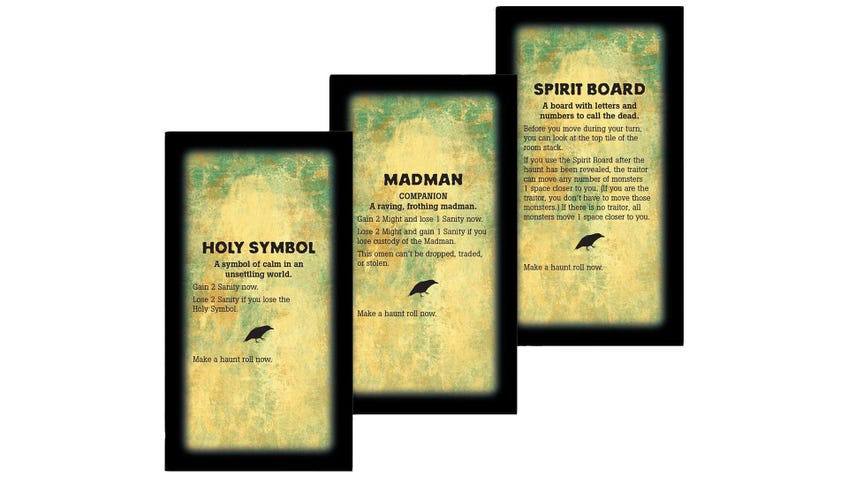
Haunt setup
Whichever player is the traitor must take the Traitor’s Tome and leave the room. They need to find the numbered scenario you are playing and read through the instructions. Refer to “The Traitor’s New Powers” on page 17 and the “How Monsters Work” section on page 18 if you need anything clarifying about what you need to do.
If there is a traitor, their goal is usually to kill all the other players in the game. Sometimes they’ll have more unique aims, such as getting one of the player characters into a certain room with an item or non-player characters.
The Traitor’s Tome usually does a good job in outlining what the traitor needs to know, but sometimes Betrayal can present rules or elements that appear messy and confusing. We’d advise playing a little fast and loose with things, and to not let the rules take over the game’s atmosphere or pacing.
All the players who aren’t the traitor become the heroes and must open the Secrets of Survival book and find the matching scenario. These players then read the instructions together and are free to discuss certain tactics and preparations. The heroes’ aims are often varied, sometimes requiring players to find a certain item or room. All the necessary rules are almost always listed on the scenario’s page in the Secrets of Survival book.
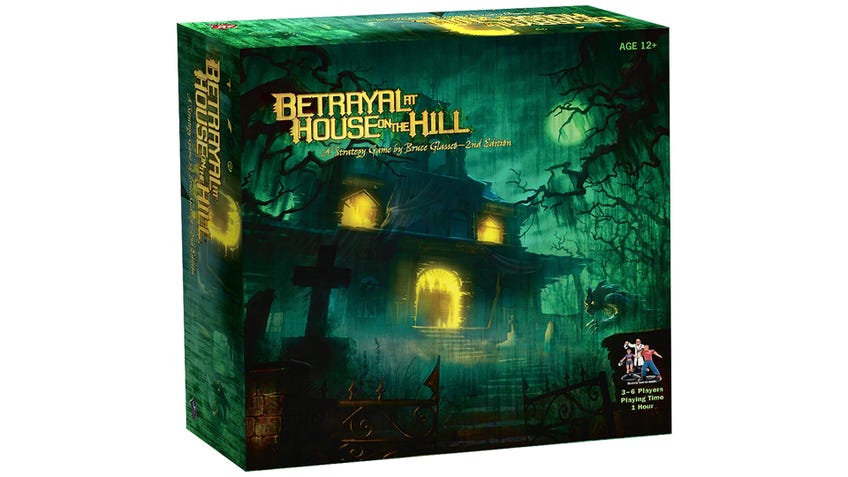
Haunt gameplay rules
Once both the traitor and the heroes are ready, they all reconvene around the table and begin the haunt phase of the game.
The traitor will often need to place some tokens or various other components in order to prepare the mansion for the current scenario. The Traitor’s Tome instructs the player on what they will need to place where.
The most important thing to remember here is for the heroes to keep their objectives and plans as secret as possible. The traitor is welcome to voice their plans if they wish to, but it’s advised that the heroes keep their aims to themselves if they want a chance at winning.
All players have to tell each other what they’re doing during their turn, but they do not need to reveal why they are doing or what the wider plan involves.
Each of the heroes take their turns starting with the hero on the traitor’s left and moving in a clockwise fashion. The same rules from the exploration phase still apply to all players, except you no longer need to perform a haunt roll after drawing an Omen card.
The traitor also gets to choose to ignore any harmful or negative text on a room tile and avoid being negatively affected by event cards - this also counts for the Bite omen card.
Once all the heroes have gone, it is time for the traitor’s turn. Depending on the haunt, the traitor may have any number of monsters under their control - these monsters take their turns after the traitor.
Whenever a player character attempts to leave a room with an opponent inside, they must spend an extra movement to do so.
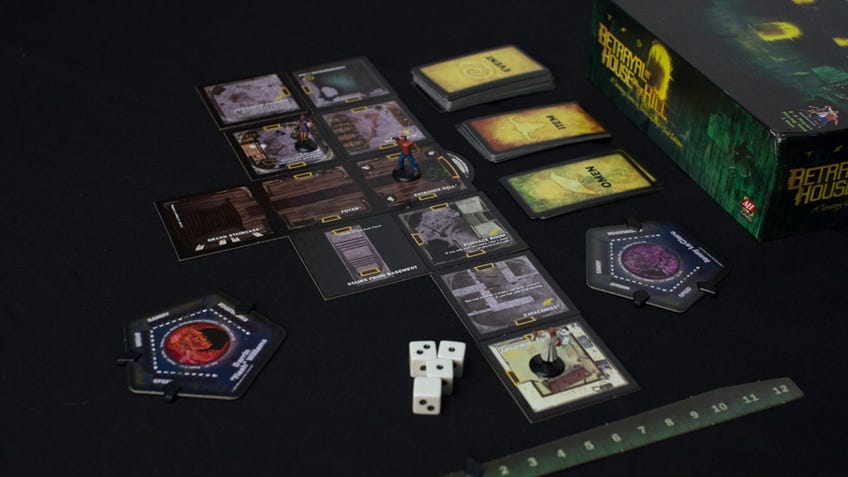
Combat
Before the haunt is revealed, none of the players can actually get into combat with one another or be killed by anything, but this changes when a haunt phase begins.
Depending on how a player attacks another, there may be different stipulations to where they can attack from and how they can attack. As with trait rolls, attacks can be split between mental and physical with some items, weapons and abilities allowing you to perform a certain type of attack.
A standard unarmed attack usually involves one player rolling their might trait against an opposing player character in the same room as them.
Both players roll the number of dice equal to their current might trait. If the attacking player rolls higher than the defending player, then they successfully deal physical damage equal to the total they rolled minus the total of the defending player’s dice. For example, if the attacking player rolled six and the defending player rolled four, then the defending player takes two damage. However, if the defending player rolls higher, then they do damage to the attacking player. In the result of a draw, neither player takes any damage.
Successful attacks can sometimes enable player characters to perform certain special actions instead of dealing damage, such as the option to steal an item if the attacking player would do more than two damage.
Some cards allow players to attack using a different trait or to attack from a distance. The revolver item, for example, allows players to shoot at another player character from a distance if they have line of sight which is an uninterrupted straight line through doorways. These attacks are decided in the same way as normal attacks, with players rolling the trait enabled by the weapon or item.
Should a player get into combat with a monster, they will need to attack with a trait that the monster possesses. For example, if a monster does not have a speed trait, a player cannot attack them using their speed trait.
You can ask the traitor controlling the monsters for any specifics regarding what traits a monster has. Most monsters are only stunned when a player defeats them, though some scenarios require the heroes to specifically kill the monsters.
Taking damage and Death
If a player character ever suffers damage, they must lose the total damage from the matching traits. For example, if a player suffers three speed damage, they will need to move the arrow on their character card down three spaces - this may also reduce their movement. If any of a player’s traits are reduced to the skull icon on their character card, they die.
Some haunt scenarios involve hero players becoming traitors if they die - it’s the traitor’s job to inform the affected hero if this is the case.
End of the game and how to win
The heroes win the game if they successfully complete all their objectives with at least one hero still alive. If all the heroes perish, they lose the game automatically.
The traitor wins the game if they complete all their objectives - or if all the heroes die.
Depending upon whether the heroes win or lose, they will have to read out the corresponding paragraph from the scenario page in the Secrets of Survival book - and revel in their victory or mourn their defeat.






